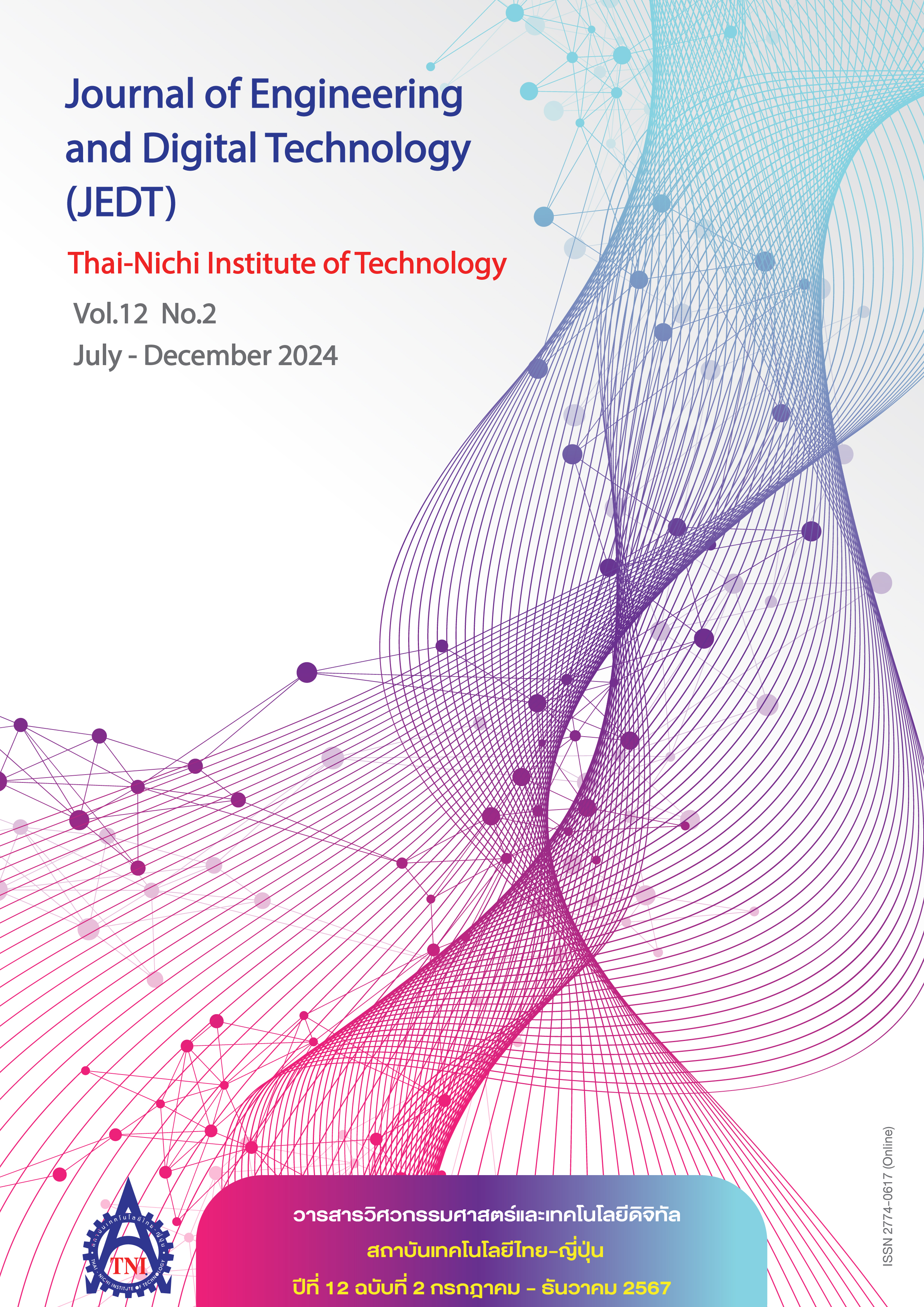การศึกษาการก่อตัวของซีเมนต์เพสต์ ความสามารถในการทำงานได้และกำลังอัดของมอร์ตาร์ผสมน้ำยางข้น
Main Article Content
บทคัดย่อ
งานวิจัยนี้มีวัตถุประสงค์เพื่อศึกษาคุณสมบัติทางกายภาพและทางกลของซีเมนต์เพสต์และมอร์ตาร์ผสมน้ำยางข้นชนิดแอมโมเนียต่ำ โดยทางคุณสมบัติทางกายภาพพิจารณาความข้นเหลวปกติและระยะเวลาการก่อตัวเริ่มต้นของซีเมนต์เพสต์ รวมถึงความสามารถในการทำงานได้ของมอร์ตาร์ ส่วนคุณสมบัติทางกลได้ศึกษากำลังอัดของมอร์ตาร์ผสมน้ำยางข้นที่อายุ 3, 7, 14 และ 28 วัน กำหนดอัตราส่วนการแทนที่ด้วยน้ำยางข้นเท่ากับร้อยละ 0.5, 1.0, 1.5 และ 2.0 โดยน้ำหนักของน้ำ ผลการทดลองพบว่าน้ำยางข้นทำให้ซีเมนต์เพสต์มีความต้องการปริมาณน้ำที่ความข้นเหลวปกติ และระยะเวลาการก่อตัวต้นเพิ่มขึ้น ทั้งนี้ยังทำให้ความต้องการน้ำเพิ่มขึ้น เพื่อรักษาค่าการไหลให้คงที่ในช่วงร้อยละ 110±5 ส่วนกำลังอัดมีแนวโน้มลดลงเมื่อเทียบกับมอร์ตาร์ควบคุมและพบว่าการแทนที่น้ำยางข้นในอัตราส่วนร้อยละ 1.0 โดยน้ำหนักของน้ำเป็นอัตราการแทนที่ที่เหมาะสมที่สุด เนื่องจากให้กำลังอัดสูงสุดรองจากมอร์ตาร์ชุดควบคุม กล่าวคือมีกำลังอัดที่อายุ 28 วัน เท่ากับ 29.68 MPa ซึ่งเพียงพอต่อการใช้งานทั่วไป และยังมีระยะเวลาการก่อตัวต้นเพิ่มขึ้นจากชุดควบคุมถึง 30 นาที ซึ่งจะทำให้การทำงานสะดวกสบายมากยิ่งขึ้น
Article Details

This work is licensed under a Creative Commons Attribution-NonCommercial-NoDerivatives 4.0 International License.
นโยบายการรับบทความ
กองบรรณาธิการวารสารสถาบันเทคโนโลยีไทย-ญี่ปุ่น มีความยินดีรับบทความจากอาจารย์ประจำ และผู้ทรงคุณวุฒิในสาขาวิศวกรรมศาสตร์และเทคโนโลยี ที่เขียนเป็นภาษาไทยหรือภาษาอังกฤษ ซึ่งผลงานวิชาการที่ส่งมาขอตีพิมพ์ต้องไม่เคยเผยแพร่ในสิ่งพิมพ์อื่นใดมาก่อน และต้องไม่อยู่ในระหว่างการพิจารณาของวารสารอื่นที่นำส่ง ดังนั้นผู้สนใจที่จะร่วมเผยแพร่ผลงานและความรู้ที่ศึกษามาสามารถนำส่งบทความได้ที่กองบรรณาธิการเพื่อเสนอต่อคณะกรรมการกลั่นกรองบทความพิจารณาจัดพิมพ์ในวารสารต่อไป ทั้งนี้บทความที่สามารถเผยแพร่ได้ประกอบด้วยบทความวิจัย ผู้สนใจสามารถศึกษาและจัดเตรียมบทความจากคำแนะนำสำหรับผู้เขียนบทความ
การละเมิดลิขสิทธิ์ถือเป็นความรับผิดชอบของผู้ส่งบทความโดยตรง บทความที่ได้รับการตีพิมพ์ต้องผ่านการพิจารณากลั่นกรองคุณภาพจากผู้ทรงคุณวุฒิและได้รับความเห็นชอบจากกองบรรณาธิการ
ข้อความที่ปรากฏภายในบทความของแต่ละบทความที่ตีพิมพ์ในวารสารวิชาการเล่มนี้ เป็น ความคิดเห็นส่วนตัวของผู้เขียนแต่ละท่าน ไม่เกี่ยวข้องกับสถาบันเทคโนโลยีไทย-ญี่ปุ่น และคณาจารย์ท่านอื่น ๆ ในสถาบัน แต่อย่างใด ความรับผิดชอบด้านเนื้อหาและการตรวจร่างบทความแต่ละบทความเป็นของผู้เขียนแต่ละท่าน หากมีความผิดพลาดใด ๆ ผู้เขียนแต่ละท่านจะต้องรับผิดชอบบทความของตนเองแต่ผู้เดียว
กองบรรณาธิการขอสงวนสิทธิ์มิให้นำเนื้อหา ทัศนะ หรือข้อคิดเห็นใด ๆ ของบทความในวารสารสถาบันเทคโนโลยีไทย-ญี่ปุ่น ไปเผยแพร่ก่อนได้รับอนุญาตจากผู้นิพนธ์ อย่างเป็นลายลักษณ์อักษร ผลงานที่ได้รับการตีพิมพ์ถือเป็นลิขสิทธิ์ของวารสารสถาบันเทคโนโลยีไทย-ญี่ปุ่น
ผู้ประสงค์จะส่งบทความเพื่อตีพิมพ์ในวารสารวิชาการ สถาบันเทคโนโลยีไทย-ญี่ปุ่น สามารถส่ง Online ที่ https://www.tci-thaijo.org/index.php/TNIJournal/ โปรดสมัครสมาชิก (Register) โดยกรอกรายละเอียดให้ครบถ้วนหากต้องการสอบถามข้อมูลเพิ่มเติมที่
- กองบรรณาธิการ วารสารสถาบันเทคโนโลยีไทย-ญี่ปุ่น
- ฝ่ายวิจัยและนวัตกรรม สถาบันเทคโนโลยีไทย-ญี่ปุ่น
เลขที่ 1771/1 สถาบันเทคโนโลยีไทย-ญี่ปุ่น ซอยพัฒนาการ 37-39 ถนนพัฒนาการ แขวงสวนหลวง เขตสวนหลวง กรุงเทพมหานคร 10250 ติดต่อกับคุณพิมพ์รต พิพัฒนกุล (02) 763-2752 , คุณจุฑามาศ ประสพสันติ์ (02) 763-2600 Ext. 2402 Fax. (02) 763-2754 หรือ E-mail: JEDT@tni.ac.th
References
C. Kererat, W. Kroehong, S. Thaipum, and P. Chindaprasirt, “Bottom ash stabilized with cement and para rubber latex for road base applications,” Case Stud. Constr. Mater., vol. 17, Dec. 2022, Art. no. e01259, doi: 10.1016/j.cscm.2022.e01259.
M. Hoy et al., “Effect of wetting and drying cycles on mechanical strength of cement-natural rubber latex stabilized recycled concrete aggregate,” Constr. Build. Mater., vol. 394, Aug. 2023, Art. no. 132301, doi: 10.1016/j.conbuildmat.2023.132301.
P. Choi and K.-K. Yun, “Experimental analysis of latex-solid content effect on early-age and autogenous shrinkage of very-early strength latex-modified concrete,” Constr. Build. Mater., vol. 65, pp. 396–404, Aug. 2014, doi: 10.1016/j.conbuildmat.2014.05.007.
A. S. Al-Luhybi, I. A. Aziz, and K. I. Mohammad, “Experimental assessment of mechanical and physical performance of latex modified concrete with fine recycled aggregate,” Structures, vol. 48, pp. 1932–1938, Feb. 2023, doi: 10.1016/j.istruc.2023.01.069.
T. Yaowarat et al., “Improvement of flexural strength of concrete pavements using natural rubber latex,” Constr. Build. Mater., vol. 282, May 2021, Art. no. 122704, doi: 10.1016/j.conbuildmat.2021.122704.
F. Moodi, A. Kashi, A. A. Ramezanianpour, and M. Pourebrahimi, “Investigation on mechanical and durability properties of polymer and latex-modified concretes,” Constr. Build. Mater., vol. 191, pp. 145–154, Dec. 2018, doi: 10.1016/j.conbuildmat.2018.09.198.
H. Bilal, T. Chen, M. Ren, X. Gao, and A. Su, “Influence of silica fume, metakaolin & SBR latex on strength and durability performance of pervious concrete,” Constr. Build. Mater., vol. 275, Mar. 2021, Art. no. 122124, doi: 10.1016/j.conbuildmat.2020.122124.
B. Muhammad and M. Ismail, “Performance of natural rubber latex modified concrete in acidic and sulfated environments,” Constr. Build. Mater., vol. 31, pp. 129–134, Jun. 2012, doi: 10.1016/j.conbuildmat.2011.12.099.
P. Khamput and K. Suweero, “Properties of mortar mixing with medium ammonia concentrated latex,” Energy Procedia, vol. 9, pp. 559–567, Nov. 2011, doi: 10.1016/j.egypro.2011.09.065.
P. Nirot, P. Sutthiwattana, and J. Wongpa, “Effects of surfactant on compressive strength and density of concrete containing para rubber latex,” (in Thai), J. King Mongkut’s Univ. Technol. North Bangkok, vol. 33, no. 2, pp. 603–612, 2023.
B. Warinlai, U. Patipanpoomsakul, and P. Krammart, “Basic properties and carbonation of concrete with partial replacement of cement by rubber latex and limestone powder,” (in Thai), J. Ind. Technol., vol. 18, no. 2, pp. 125–142, 2002.
J. Ahmad, O. Zaid, M. S. Siddique, F. Aslam, H. Alabduljabbar, and K. M. Khedher, “Mechanical and durability characteristics of sustainable coconut fibers reinforced concrete with incorporation of marble powder,” Mater. Res. Express, vol. 8, no. 7, 2021, Art. no. 075505, doi: 10.1088/2053-1591/ac10d3.
S. Iffat, “Relation between density and compressive strength of hardened concrete,” Concrete Res. Lett., vol. 6, no. 4, pp. 182–189, Dec. 2015.
Standard Test Method for Compressive Strength of Hydraulic Cement Mortars (Using 2-in. or [50-mm] Cube Specimens), ASTM C109/C109M-20, Mar. 2020. [Online]. Available: https://www.astm.org/c0109_c0109m-20.html
Thai Industrial Standard: Hydraulic Cement, TIS 2594–2556, Thai Industrial Standards Institute, Ministry of Industry, Bangkok, Thailand, 2013.
Notification of Ministry of Industry: The Hydraulic Cement Industry Product is Specified as a Material for Making Industrial Products, Concrete and Cement Product Groups (no. 6819), B. E. 2565, Thai Government Gazette 139(282D), Ministry of Industry, Bangkok, Thailand, Dec. 1, 2022.
Standard Test Method for Amount of Water Required for Normal Consistency of Hydraulic Cement Paste, ASTM C187-16, Jun. 2023. [Online]. Available: https://www.astm.org/c0187-16.html
Standard Test Methods for Time of Setting of Hydraulic Cement by Vicat Needle, ASTM C191-21, Nov. 2021. [Online]. Available: https://www.astm.org/standards/c191
Standard Test Method for Flow of Hydraulic Cement Mortar, ASTM C1437-20, Oct. 2020. [Online]. Available: https://www.astm.org/c1437-20.html
Y.-C. Wei, D. Zhu, W.-Y. Xie, J.-H. Xia, M.-F. He, and S. Liao, “In-situ observation of spatial organization of natural rubber latex particles and exploring the relationship between particle size and mechanical properties of natural rubber,” Indus. Crops Prod., vol. 180, Jun. 2022, Art. no. 114737, doi: 10.1016/j.indcrop.2022.114737.
Y. Guo, K. Bao, X. Wu, D. Han, and J. Zhang, “Morphology and aggregation process of natural rubber particles,” Indus. Crops Prod., vol. 203, Nov. 2023, Art. no. 117153, doi: 10.1016/j.indcrop.2023.117153.
A. M. Neville and J. J. Brooks, Concrete Technology, 2nd ed. Harlow, England: Prentice Hall, 2010.
Y. Ohama, “Principle of latex modification and some typical properties of latex-modified mortars and concretes adhesion; binders (materials); bond (paste to aggregate); carbonation; chlorides; curing; diffusion;,” Mater. J., vol. 84, no. 6, pp. 511–518, Nov. 1987.

